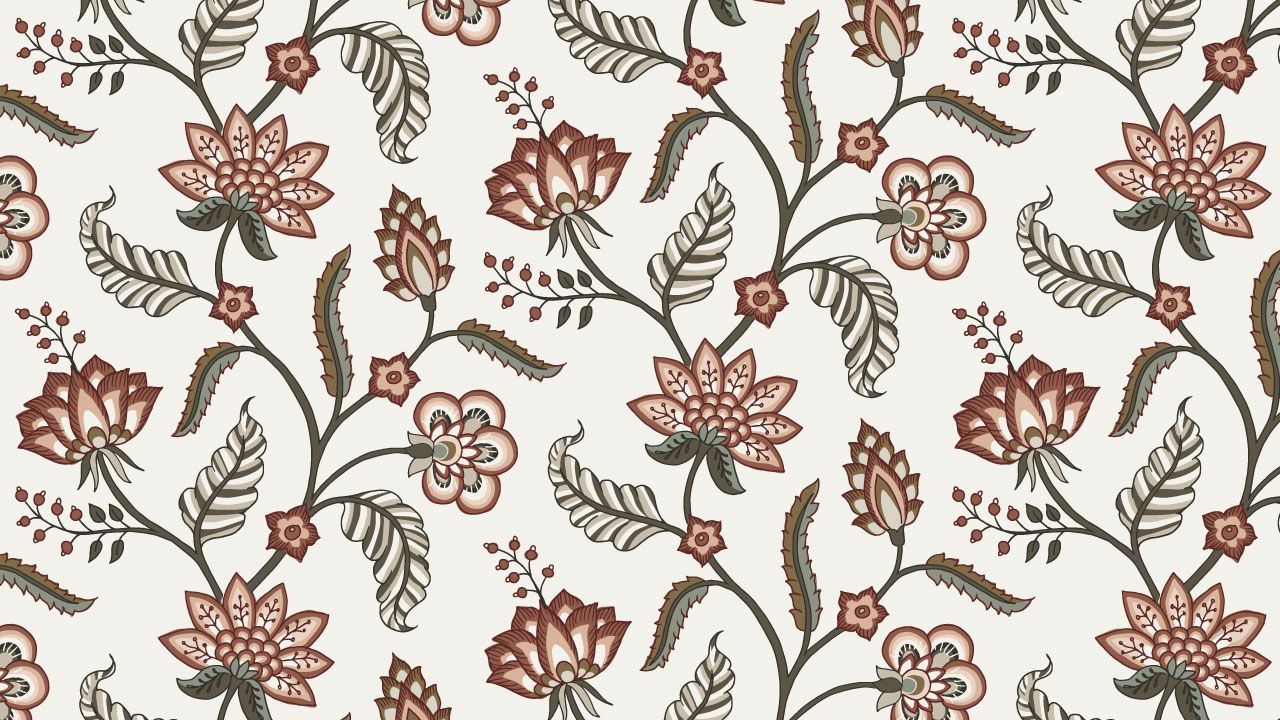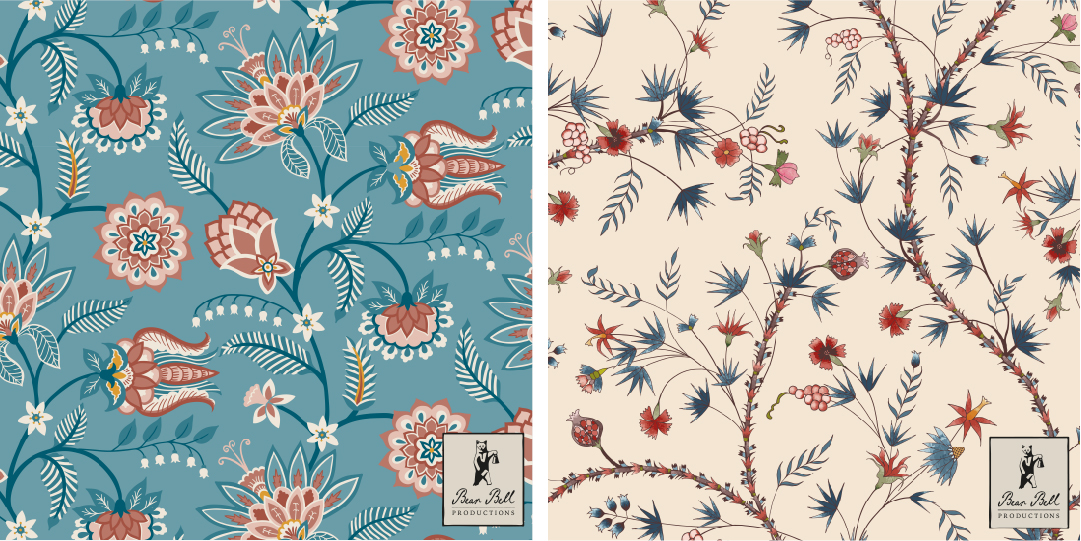Historic Pattern Styles: Indian Floral
Apr 28, 2023
Indian florals have been a recurring element within fashion and interior design from the ancient modern era until the present day. And now they are seen everywhere, as popular as ever, on clothing, wallpaper, furniture and all kinds of home textiles.
Yet this is nothing compared to the frenzy they created when introduced to Europe in the 17th century. People went crazy over these beautiful, colorful, printed and painted fabrics; that actually revolutionized and in some way, democratized fashion and changed the way people, both rich and poor would clothe themselves and decorate their homes.
It’s an interesting piece of pattern history and a story about one of the most beloved classic pattern designs, so let’s get to know it better...

Image 1: Dress (robe à l'anglaise) and skirts in chintz, ca. 1770-1790: | Image 2: Chintz fabric | Image 3: Indienne "Le Grand Corail" Wesserling textile museum
THE HISTORY OF THE INDIAN FLORALS STYLE
The history of Indian Florals is as abundant and exciting as the style itself, with its abundant variations. Throughout history it has also been referred to by different names. Here are 3 names that are often used for Indian Floral patterns:
-
Indienne: is French and means ”that what comes from India” and originally referred to a fabric with a printed and painted floral pattern. Produced in India and exported to France between the 17th and 18th centuries, later on, Indienne became the term for any floral pattern, either produced in India or Europe. An Indienne fabric was sometimes linen, yet cotton was the main material preferred in Europe during this time.
-
Toile peinte - which means painted cloth in French.
-
Chintz, is an anglicized version of the Indian word chint, which means “to sprinkle” and this is probably the most commonly used English term for this fabric and refers to cotton fabric with a polished or glazed surface.
The story of Indian floral patterns are tightly connected to the textiles and printed cotton, which is the foundation for the spread of this style.
THE INFLUENCES THAT SHAPED THE INDIAN FLORAL STYLE
When we look at preserved antique Indienne textiles that you can see at different museums and collections, we can identify a couple of specific traits in the motifs that will give us a hint of one of the most important influences.
For instance:
- all these patterns have trailing branches - it can be anything from chunky tree trunks to more delicate twigs and stems.
- another typical trait is the variation of flowers and how it’s depicting different stages of budding, blossoming, bearing fruit and seed pods.
The reason is of course partly a decorative and artistic one, but there is also one specific thing that seems to be a strong influence; because there is a common motif that you often find in antique Indian bed curtains called Palampores - which is the Tree of Life.
The tree of life is a widespread well known theme and myth in most religions and philosophies around the world - from ancient cultures to Jewish, Muslim and Christian but also in cultures on other continents like the Mayan in South America.
For Palampores, the full motif of a growing tree would work well, with the rocky ground and a complete tree crown. But for other products, like upholstery, dresses, scarves, robes and other textiles the designs needed to be adapted to be able to repeat seamlessly. So the ground and tree trunk were skipped and only the trailing branches, flowers and leaves remained.
PRINTED INDIAN COTTONS CONQUER EUROPE
The printed and painted cottons from India were first introduced to France in the 16th century and became immensely popular among all levels of society during the late 17th century and 18th century.
Just imagine how it was before. As a middle class woman, you would probably own one or perhaps two dresses, in black, or maybe brown. That’s what you and your family could afford. And you didn’t want to wash it, ever, afraid of the color fading. Then with the printed cottons: white, soft and light cloth, with vivid colors of red and blue, all filled with beautiful flowers. And you could afford it too. Perhaps even a new dress once a year!

18th century dresses
And it wasn’t just beautiful and comfortable to wear. It could be washed, without fading those beautiful colors. In fact, they got even more beautiful and softer the more you washed it. No wonder it became so popular and in demand.
These Indienne fabrics were imported by the French East India company through Marseille and then made into dresses, robes, jackets, undergarments, upholstery, cushions, bedding and bed curtains. The company quickly understood the value of this new market, and wanted to bring production to France with the advantage of skipping shipment and middle hands.
Even the French manufacturers tried to ride the printed cotton wave and imitated these chintzes and Indienne fabrics. The French East India company sent people to India try to learn their dyeing secrets, yet no-one could figure out the secret of creating those color-fast textile, not even the best European chemists. It wasn’t until the early 1800s that a scientific explanation to the Indian vivid and dye fast colors was given.
BUT there was also a downside to this fabric revolution. The french manufacturers of wool and silk started to suffer because of the import of Indian cottons and the French production of imitations. It got so bad that cottons were prohibited in France and England from early 1700s.
 18th century dresses
18th century dresses
Imagine being a woman during this time, getting a taste for these fabulous fabrics that must have been a life changer for many. And once you had been given the chance to own and wear something like that, who would want to give it up?
Well, people didn’t, and despite the threats of being imprisoned, sent to the galleys or even executed, they found other ways to make or smuggle these fabrics to satisfy the underground market and there are some terrible examples of people getting arrested and stripped in the street for getting caught wearing chintz.
But the smuggling and underground production continued anyway and finally the ban had to be lifted in 1759.
THE CHARACTER OF INDIAN FLORAL PATTERNS
When it comes to Indian floral patterns the variations are endless, but let’s define and conceptualize this with some examples.
To not make things too complex, I have divided the Indian floral patterns into two main categories:
-
The robust Indian style: Where the flowers and leaves come in many variations, both large and small. They vary in detail and complexity, some being extremely detailed and others more simplified. Patterns within this style are fairly dense in their layout and have more direction to them. The flowers are stylized and imaginary, inspired by the Indian flora.

Indian robust style: Characterized by a thicker, main tree branch, with a structure of some kind. From this thinner and more delicate twigs and branches spring out.
-
The delicate European style: Its layout is non-directional, the flowers more conform, smaller in size, more realistic, yet combine different varieties and mainly inspired by a European flora. The patterns are also more loose, not as tightly arranged and gives a more airy impression compared to the Indian robust style.

Combination of Robust & European delicate style: the overall feeling is light and airy, even though there are larger motifs featured too. Image: Chintz (India) 18th Century - Cooper Hewitt, Smithsonian design museum
Of course, there is a range of combinations of these two styles, but at least it’s an attempt to define some of the occurring characteristics. The fun thing about this, and what also the 18th and 19th century designers experienced, is the diversity and versatility in this type of floral patterns and the endless ways you can create these patterns.
THE COMPOSITION OF INDIAN FLORAL PATTERNS
There are some design sketches to be found in collections of museums where you can see how the artist has constructed the repeat, with exquisite harmony and flow, depending on the complexity and variation.
The winding branches were mostly outlined in black or brown and depending on the style and thickness painted with one or several colors. The branches were often made in a similar fashion, one stem, splitting into two branches which in turn then are divided into several and smaller twigs and stems to where the flowers and leaves are attached. This ”tree crown” design also makes for an even distribution of the floral elements and harmonic layout that will work for the repeat in a straight or a half-drop.
 Indian Floral designs by ©Bärbel Dressler.
Indian Floral designs by ©Bärbel Dressler.
The motifs are not overlapping much, especially not the flowers. Thinner twigs can cross over each other and a leaf can be tucked behind a stem or branch, but the overall impression has to be even and somewhat airy. Although there is usually a lot of variation in the different motif elements and shapes, it’s all tied together with an even distribution and spacing.
WANT TO LEARN ABOUT HISTORICAL AND CLASSICAL PATTERN STYLES, TYPES AND MOTIFS?


Pop a pin in it and save for later!
